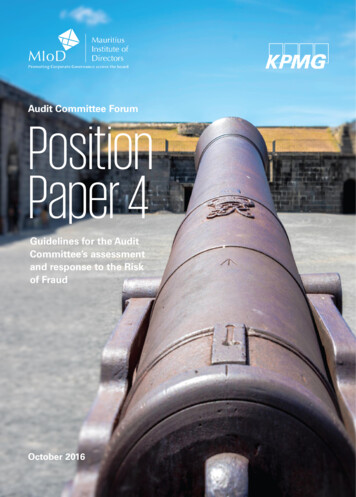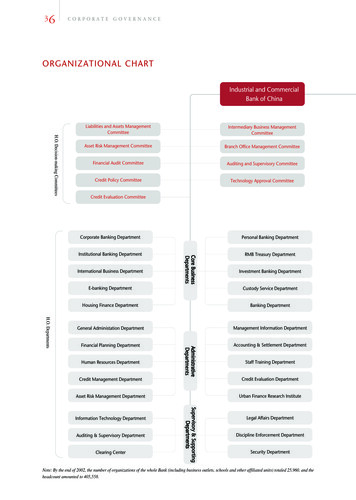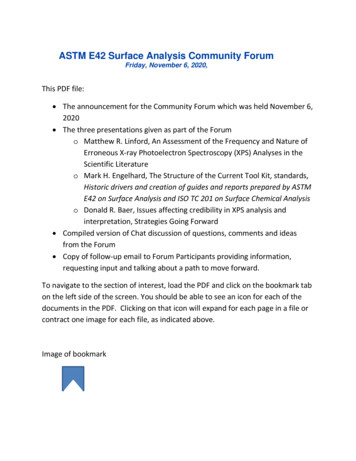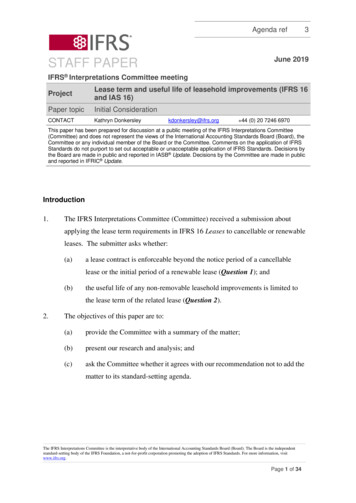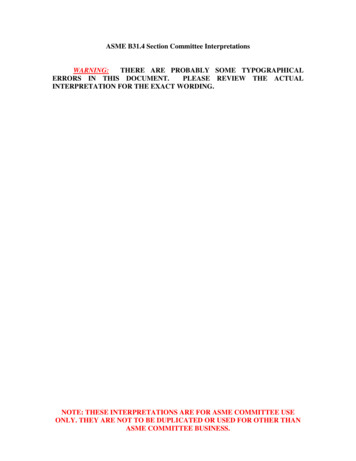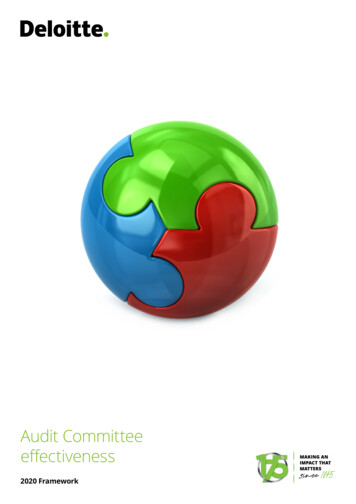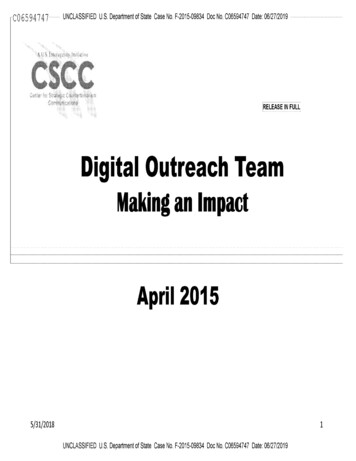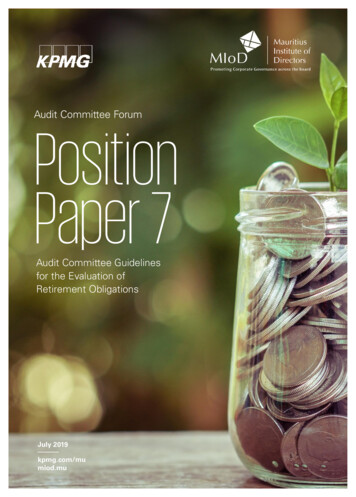
Transcription
Audit Committee ForumPositionPaper 7Audit Committee Guidelinesfor the Evaluation ofRetirement ObligationsJuly 2019kpmg.com/mumiod.muPosition Paper 61
About the AuditCommittee ForumRecognising the importance of Audit Committeesas part of good Corporate Governance, theMauritius Institute of Directors (MIoD) and KPMGhave set up the Audit Committee Forum (theForum) in order to help Audit Committees inMauritius, in both the public and the privatesectors, improve their effectiveness.Position Paper seriesThe purpose of the Forum is to help AuditCommittee members adapt to their changing role.Historically, Audit Committees have largely beenleft on their own to keep pace with rapidlychanging information related to governance, riskmanagement, audit issues, accounting, financialreporting, current issues, future changes andinternational developments.Position Paper 7 deals with the AuditCommittee’s guidelines for the evaluation ofretirement obligations.The Forum provides guidance for AuditCommittees based on the latest legislative andregulatory requirements. It also highlights bestpractice guidance to enable Audit Committeemembers to carry out their responsibilitieseffectively. To this end, it provides a valuablesource of information to Audit Committeemembers and acts as a resource to which theycan turn for information or to share knowledge.The Forum’s primary objective is thus tocommunicate with Audit Committee membersand enhance their awareness and ability toimplement effective Audit Committee processes.Members of the ForumCollectively, the Forum is made up of thefollowing members drawn from diverseprofessional backgrounds with significantexperience in both the private and the publicsectors.Mr Bernard Yen was co-opted as a member forPosition Paper 7.Position Paper 6The Position Papers, produced periodically by theForum, aim to provide Board directors andspecifically Audit Committee members with basicbest practice guidance notes to assist in therunning of an effective Audit Committee.Previous Position Papers are listed below and maybe accessed at http://www.kpmg.com/mu andhttp://www.miod.mu/.Paper 1: Best Practice Guidance Notes for Audit Committees(July 2014)Paper 2: Interaction of Audit Committee with Internal andExternal Auditors (May 2015)Paper 3: The Audit Committee’s Role in Control andManagement of Risk (December 2015)Paper 4: Guidelines for the Audit Committee’s assessmentand response to the Risk of Fraud (October 2016)Paper 5: Guidelines for the Audit Committee’s approach toInformation Technology Risk (July 2017)Paper 6: Audit Committee Guidelines for evaluatingwhistleblowing systems (September 2018)Ujoodha Sheila – ChairpersonKee Mew MervynAumeerally FerielKing AntoineChung JohnKoenig FabriceDe Marassé Enouf MauriceLeung Shing GeorgesDinan PierreMolaye SanjayGooroochurn BharateeMooroogen SumitaIbrahim NesmahRamdin-Clark MadhaviJolicoeur EddyReetun KhemrajSecretary:MIoD Co-ordinator:Bishundat VarshaMulung Nafeeza2
Contents1. Introduction42. Forms of employee benefits and theirmanagement63. Legislations for retirement obligations94. The role of the Audit Committee inthe evaluation of retirementobligations105. The role of the External Auditor in theevaluation of retirement obligations126. Conclusion13AppendicesA. An example to illustrate howactuarial calculations are performedand the disclosures built up15B. Section 49 of the EmploymentRights Act18Sources that have been used in writing this Paper: Employment Rights Act. 2008 (Republic of Mauritius). Updated, August 02008%20-%20updated%20as%20at%20Aug%2018.pdf Financial Reporting Council. 2018. The Audit of defined benefit obligations: Findings from2017/2018 Audit Quality Reviews. London, -pension-obligations v4.pdf Sweatman, Scott. 2017. 20 Questions Directors Should Ask about Pension Governance. 2nded. Toronto, Canada: Chartered Professional Accountants of Canada.Position Paper 63
IntroductionRetirement obligations can be referred to as the future expenses or liabilities associated with a pensionor retirement plan. Organisations provide employees with a pension plan as part of a larger array ofemployment benefits. The pension plans are structured so as to provide a periodic and reliable source ofincome when the employee reaches the plan's normal retirement age. Other retirement plans providelump sums at retirement or assistance with medical costs during retirement.Key TermsA defined benefit plan is one where the amount of pension or other benefit to be paid is predefined in terms ofa formula based on service and career average or final salary of the employee, irrespective of how any assetsset aside to fund the benefit in advance actually perform.A defined contribution plan is one where the amount of contributions to be paid into the plan is predefined interms of fixed percentages of salary throughout the employee’s career and the resulting pension or other benefitdepends on the accumulated value of these contributions and investment returns earned thereon, as well asprevailing costs of purchasing pensions at retirement which cannot be predicted in advance.4Position Paper 7
Accounting Standards require organisations to measureand disclose retirement obligations as well as theperformance and financial conditions of their plans at theend of each accounting period. Under the InternationalFinancial Reporting Standards (IFRS), more specificallythe International Accounting Standard 19 (IAS 19), anorganisation:—uses an actuarial technique to estimate the ultimatecost of the benefits that employees have earned inreturn for their services in the current and priorperiods;—discounts the defined benefit in order to determineits present value and the current service cost;—deducts the fair value of any plan assets from thepresent value of the defined benefits;—determines the amount of the deficit or surplus ofthe plan; and—determines the respective amounts to berecognised in profit or loss and othercomprehensive income in the current period.The measurements are updated at each reporting date.Retirement obligations may be an importantconsideration for Audit Committee members. The netPosition Paper 7pension obligation appearing on the balance sheet maynot in itself be significant while the related pensionassets and liabilities are significant balances appearing inthe financial statements. The valuations of these assetsand liabilities are complex and rest on a range ofassumptions and management judgements which maycause a risk of material misstatement or manipulationthrough management bias. An incorrect valuation of thepension scheme assets or liabilities could easily lead to amaterial misstatement in the net defined benefit liabilityor asset in the entity’s financial statements.Also, where an organisation has a significant net definedbenefit liability, the directors should carefully considerhow this may affect its future viability or going concern.They should ensure that the relevant disclosures in theannual report and financial statements are fair, balancedand understandable so that users of the financialstatements have the information they need tounderstand the risks that funding the pension plan putson the business.The level of security for retirement obligations in thebalance sheet is also important to employees of anorganisation. If, for example, they are too large comparedto the realisable assets of the organisation and the latterfaces financial difficulties, the assets may not besufficient to repay the obligations.5
Forms of employee benefitsand their managementIAS 19 Employee Benefits is the relevant standard for accounting and reporting on all forms of employee benefitsprovided by employers in Mauritius.IAS 19 covers four categoriesof employee benefits:Category A: Short-term employee benefits, such as the following (if expected to be settled wholly beforetwelve months after the end of the annual reporting period in which the employees render the relatedservices): wages, salaries and social security contributions, paid annual leave and paid sick leave, profit-sharingand bonuses, and non-monetary benefits (such as medical care, housing, cars and free or subsidised goods orservices) for current employees.Category B: Long-term employee benefits provided during employment, such as passage benefits, longservice leave or sabbatical leave, jubilee or other long-service benefits, long-term disability benefits.Category C: Termination benefits.Category D: Post-employment benefits such as retirement benefits (e.g. pensions and lump sum paymentson retirement), post-employment life insurance and post-employment medical care.Short-term employee benefitsFor short-term employee benefits under category A, IAS 19 requires the employer to recognise the expected cost ofthese short-term benefits when an employee has provided the related service in exchange for those benefits and suchcalculations are relatively straightforward.6Position Paper 7
Long-term employee benefitsFor long-term employee benefits under category B, IAS19 requires the same recognition and measurement asfor post-employment benefits under category D.However, instead of being recognised partly in profit orloss (POL) and partly in other comprehensive income(OCI), all changes in the carrying amount of liabilities forsuch long-term benefits are recognised in POL only andno specific disclosures are required. In Mauritius, typicalexamples of such benefits include passage benefits thatare paid every 2, 3, 5 or 7 years and significant cashpayments or gifts to employees attaining 5, 10, 20 or 30years of service.Termination benefitsTermination benefits under category C are employeebenefits payable as a result of either the employer'sdecision to terminate an employee’s employment beforethe normal retirement date or an employee’s decision toaccept an offer of benefits in exchange for thetermination of employment. The employer is required torecognise termination benefits at the earlier of:i. when it can no longer withdraw an offer of thosebenefits; andii. when it recognizes any related restructuring costs.In Mauritius, any voluntary retirement scheme orequivalent offered by the employer would fall under thiscategory and the estimated capital cost of these benefitswould typically be recognized in POL straightaway.Post-employment benefitsFor categories B and D, the calculations are morecomplicated unless the plans are classified as definedcontribution in nature.Under defined contribution plans, an employer pays fixedcontributions into a separate organisation (a fund) andwill have no legal or constructive obligation to pay furthercontributions even if the assets of the fund haveperformed poorly. IAS 19 requires employers torecognise contributions to a defined contribution planwhen employees have provided service in exchange forthose contributions.IAS 19 also allows for certain State social security andmulti-employer plans to be treated and accounted for asdefined contribution plans even when they may in factbe defined benefit in nature. For example in Mauritius,the National Pension Fund (NPF) can be treated asdefined contribution under IAS 19 because an employer'sliability is limited to making the required monthlycontributions to it. Similarly, some conglomerates inMauritius sponsor a multi-employer group definedbenefit plan where the holding company accounts for thewhole plan as a defined benefit plan and the participatingPosition Paper 7subsidiaries can then account for their share ofcontributions to the plan as if they were definedcontribution in nature for them.All other post-employment or other long-term benefitplans are defined benefit plans typically requiring the useof professional actuaries in computing their costs andpreparing the relevant disclosures in financialstatements. This is because the benefits payable fromthose plans have to be estimated and projected over along period into the future, taking into account thebenefit formulae and the various probabilities of paymentrelating to retirement, death, resignation or other causes.Defined benefit plans may be unfunded, or they may bewholly or partly funded. IAS 19 requires the employer to:1) account not only for its legal obligation, but also forany constructive obligation that arises from theemployer’s practices;2) determine the present value of defined benefitobligations and the fair value of any plan assets withsufficient regularity, ideally at the end of eachreporting period. In Mauritius, most employers haveopted for a full actuarial valuation at the end of eachreporting year. Some large listed employers haveopted for a quarterly assessment in line with theirreporting requirements and some smaller employershave decided to ask their actuaries to carry out fullactuarial valuations once every 3 years and useapproximate roll-forward calculations in theintermediate years;3) use an actuarial method called the projected unitcredit method to measure its obligations and costs;4) attribute benefit to periods of service under the plan’sbenefit formula, unless an employee’s service in lateryears will lead to a materially higher level of benefitthan in earlier years;5) use unbiased and mutually compatible actuarialassumptions about demographic variables (such asemployee turnover and mortality) and financialvariables (such as future increases in salaries,changes in medical costs and particular changes inState benefits). Financial assumptions should bebased on market expectations, at the end of thereporting period, for the period over which theobligations are to be settled;6) determine the discount rate by reference to marketyields at the end of the reporting period on highquality corporate bonds (or, in countries such asMauritius where there is no deep market in suchbonds, government bonds) of a currency and termconsistent with the currency and term of the postemployment benefit obligations;7
7) deduct the fair value of any plan assets from thecarrying amount of the obligation in order todetermine the net defined benefit liability or asset;— unfunded medical insurance and other costs paid outof an employer's cash flow to retirees and theirbeneficiaries;8) limit the carrying amount of a net defined benefitasset so that it does not exceed the economicbenefits available to the employer in the form ofpotential future refunds from the plan or potentialreductions in future contributions to the plan; and— significant refunds of unused sick or local leaveentitlements on retirement; and9) recognise all changes in the net defined benefitliability or asset when they occur, as follows:i.service cost and net interest in profit or loss(POL); andii. remeasurements in other comprehensive income(OCI).The classification between items in POL and OCI arebased on what is considered to be within management’scontrol. Items in POL are generally considered to besubstantially within management’s control (e.g. salaries)and items in OCI are generally considered to be outsidemanagement’s control (e.g. changes in assumptions dueto market conditions and demographic developments).Mauritian contextTypical examples of post-employment defined benefitplans in Mauritius that require these detailed calculationsand disclosures include:— funded pension plans set up by an employer that aimto provide a pension of up to two-third (2 3) of anemployee's final salary on normal retirement at theage of 60 or 65 (often inclusive of any NPF pension orrelated offset) after completing 331 3, 35 or 40 yearsof service and any associated ancillary benefits tospouses and other dependants;— funded or unfunded top-up pension plans that aim toprovide a minimum defined benefit pension on top ofa defined contribution or other pension benefits;— unfunded discretionary pensions paid out of anemployer's cash flow to retirees who did not receivesignificant pensions from the employer's fundedpension plans when they retired;8— unfunded lump sums or gratuities on death orretirement payable by an employer under theEmployment Rights Act equal to 15 days'remuneration for each year of service (net of anypermitted deductions under the Act in respect of theemployer's share of contributions to funded pensionor retirement plans).It is interesting to note that the Employment Rights Actgratuity requirements, which are defined benefit innature, apply irrespective of whether the employer hasset up a defined benefit or defined contribution fundedpension plan for its employees.In other words, an employer who has set up a definedcontribution pension plan in order to avoid the costuncertainties of a defined benefit pension plan still hasthe cost uncertainties of a defined benefit retirementplan imposed by the Employment Rights Act, unless theemployer's contribution rate to the defined contributionplan is so high as to completely offset the Act’s liability inall or most individual cases.For the rest of this Paper, we will focus on employeebenefits under category D, i.e. pensions and lump sumpayments on retirement, which are defined benefit innature and require specialist actuarial calculations.These defined benefit obligations, net of any plan assetswhere the plans are funded, are also commonly calledretirement obligations in Mauritius.Please refer to Appendix A on page 15 of this Paper foran example to illustrate how actuarial calculations areperformed and how the disclosures are built up.Audit Committee members should pay attention to thesufficiency of the disclosures around retirementobligations in the financial statements.Position Paper 7
Legislations for retirementobligationsThere are various legislations affecting retirement obligations like the Employment Rights Act, the Pensions Act andthe Statutory Bodies Pension Funds Act. The main legislation affecting retirement obligations in Mauritius is Section49 of the Employment Rights Act, as included in Appendix B on page 18 of this Paper.The following points in Section 49 of theEmployment Rights Act are worth noting:The retirement gratuity is only payable by the last employer where the employee has worked before retiringon or after age 60 (or earlier in case of permanent incapacity). For any prior periods of employment, theprevious employers do not need to pay any such gratuity. At the time of writing this Paper, the Government isconsidering the introduction of a Portable Retirement Gratuity Fund to require all employers to make aminimum contribution to that fund (or acceptable alternatives) so that employees can benefit in future from aretirement gratuity in respect of all service provided, instead of just the service being provided to the lastemployer before retirement.Subsection (1A) allowing for the optional advance payment of the retirement gratuity at age 60 is a newprovision since 2013. It is unfortunate that this section is silent on what allowance can or should be made foradding any interest to the advance payment when the excess of the full retirement gratuity over the advancepayment is subsequently paid when the employee retires later.The definition of remuneration in subsection (5) for the purpose of calculating the retirement gratuity is subjectto interpretation and, in particular, different employers and employees may disagree on what constitutes aregular payment to be included in the calculation. For example, performance or profit-sharing bonuses can behighly variable and/or discretionary and some consider that an average of the last 3 years, rather than simplythe actual figure for the last 12 months, may be more appropriate for this purpose. Whatever theinterpretation, it is recommended that employers should ideally agree and communicate beforehand with theiremployees on how they intend to calculate their retirement gratuities in future.Subsection (3) parts (a) and (b) relate to the permitted deductions from the retirement gratuity calculations inrespect of any employer contributions to a pension fund or other scheme. It is unfortunate for employers thatthese parts only allow for roughly half the value of employer contributions to be deducted, whereas parts (c)and (d), which are almost never used, do allow for roughly the full value of unfunded pensions to be deducted.This anomaly has been highlighted to the Government by some employers in the past as it discourages manyemployers from setting up pension plans for their employees.As a result, for those employers who nevertheless contribute to pension plans for their employees, they are exposedto any underperformance of these plans because this could result in lower deductions under Section 49(3) of theEmployment Rights Act and therefore higher residual gratuities to be paid at retirement.In this context, the Private Pension Schemes Act 2012 and associated Rules issued by the Financial ServicesCommission (FSC) which licenses, regulates and supervises almost all funded pension plans in Mauritius, are anotherpart of the legislative framework to consider. Although these provisions are aimed at improving pension governanceand protection for employees in general, employers generally have an interest in ensuring that their sponsored plansare well run and appropriately invested so as to minimise the risk that they may be called upon to top up theretirement benefits paid by these plans.Position Paper 79
The role of the AuditCommittee in the evaluationof retirement obligationsIt is essential for Board members to know their responsibilities as Directors and the organisation’s roles with respectto retirement obligations. The Audit Committee, to which the Board often delegates its responsibilities regardingfinancial statements ensures that retirement obligations are well managed and reported. In carrying out its duties, theAudit Committee can take the following key elements into consideration: Proper management of the obligations Appropriate controls in place to mitigate risks related to the obligations Accurate computation of the amount of the retirement obligations Compliance with laws and regulations Correct disclosure of the retirement obligations in the financial statementsApart from obtaining confirmation from management that the organisation has formally documented and approved thepolicies and procedures related to retirement obligations, it is important for the Audit Committee to have assurancethat such policies and procedures are being duly adhered to and key controls are working as expected.The Audit Committee needs to be aware of whether the pension and other obligations are managed internally by aqualified personnel or whether this responsibility is outsourced to a professional advisor. If a pension fund is managedinternally, the Audit Committee should be made aware of any potential conflict of interest. For example, a planadministrator (who forms part of the board) cannot knowingly permit his/her own interest to conflict with his/herduties and powers as the administrator of the pension fund. If the management of a pension fund is outsourced, theAudit Committee should be informed of the credentials of the professional advisor and rationale for selecting theadvisor.10Position Paper 7
A few suggested questions that the AuditCommittee can ask to assess the accuracy ofretirement obligations:1)Have the roles of the relevant teams (e.g. HR and Accounting) been clearly mentioned in respect of theprocedures and controls on pensions and retirement benefits?2)Is the pension fund and other retirement plan managed internally or is this responsibility outsourced to aprofessional advisor?3)Have the responsibilities and accountabilities of the third party managing the pension fund been clearlystated (where applicable)?4)Has the Board evaluated the competence and independence of the third party managing the pensionfund?5)Has the pension plan’s performance been benchmarked against that of other pension funds?6)Has the Board evaluated the governance structure of the pension fund?7)What is the financial health of the pension plan? What is the size of the pension fund's asset compared tothe organisation’s operating assets?8)Have the risks associated with managing pension funds internally or by third party been assessed andcontrols put into place to mitigate those risks?9)Has the external auditor reviewed the retirement obligation independently or have they placed reliance onthird party for the evaluation and disclosure requirements?10) What mechanisms have been put into place with respect to retirement obligations that ensurecompliance with the relevant laws and regulations such as the Pensions Act and the Employment RightsAct? Have there been any changes affecting the pension plan and retirement obligations during the year?11) Has the Board sought any external guidance in case of any change in the pension plan from definedbenefit to defined contribution?12) Have the figures related to pensions and retirement obligations been properly accounted and disclosed inthe financial statements as per the IFRS requirements?13) Does the organisation clearly explain to its employees the purpose, objectives and rules of the pensionplan and associated risks?Internal Auditors can give independent assurance onretirement obligations by assessing the key controlsthat are in place.Apart from the evaluation performed by Internal Auditors,the Audit Committee can request:However, the scope of work of the Internal Auditorsmay be restricted to the extent of their skills andcompetence regarding accurate evaluation ofretirement obligations which can be very complex asmentioned in Section 2 on pages 6-8 of this Paper.—The services of professional advisors to assess theaccuracy of retirement obligations and submit a report;—External Auditors to give their feedback on the amountof the retirement obligations as part of their audit (referto Section 5 on page 12 of this Paper).Position Paper 711
The role of the ExternalAuditor in the evaluation ofretirement obligationsThe defined benefit obligation is a figure based onactuarial assumptions. External Auditors therefore needto exercise sufficient professional scepticism whenauditing these estimates. They will often engage theirown experts to provide assistance in auditing valuationsfor both the pension obligation and these more complexinvestment assets.The audit of pensions is further complicated bycompanies often having numerous schemes withdiffering benefit structures, arising from past acquisitionswhich may also include both private and public sectorarrangements, as well as open and closed schemes.Schemes will also use a range of investment managersand custodians to manage the pension scheme assets,and may also engage a pension administrator to maintainmembership details, collect contributions and paybenefits. In the light of the different parties involved,there is a need to decide upon whether reliance can beplaced on the work of the External Auditor of theseparties or whether they need to perform their own auditwork. The use of these management experts and serviceorganisations therefore needs to be carefully consideredwhen planning the audit.Auditing the defined benefit obligations and relatedpension assets encompasses a number of more complexaspects of audit including:i. Auditing significant accounting estimates;ii. Using service organisations’ and management’sexperts;iii. Using External Auditor’s experts; andInteraction with the Audit CommitteeWhere organisations have significant pension schemebalances, Audit Committees and External Auditors areexpected to discuss the findings of the actuarial reportand consider whether the audit approach taken could beenhanced. In particular, Audit Committees should ensurethat:—they discuss how the external auditor has reachedindependent estimates and ranges and how thesehave been used to benchmark againstmanagement’s assumptions;—their External Auditor clearly communicates thefinancial impact of assumptions that are at theoptimistic or pessimistic ends of the range, andwhether those assumptions have been reviewedand their reasonableness.—they consider whether the assumptions arepositioned at an appropriate place in the rangebearing in mind the circumstances of theorganisation, for example the economicenvironment, and how changes in thoseassumptions impact upon the organisation’sreported financial performance; and—they clearly understand whether the ExternalAuditor has taken a controls-based or substantiveapproach to the audit of the scheme assets and, inparticular, where these are material, how theExternal Auditor has obtained evidence to valueassets.iv. Using the work of other External Auditors and theaudit of disclosures.External Audit teams need to tie all of the key threadstogether, carrying out their work with appropriateprofessional scepticism, to reach overall soundly-basedconclusions.12Position Paper 7
ConclusionRetirement obligations remain a key consideration for employers and their employees. The various typesof retirement obligations need to be carefully understood to recognise their financial reportingrequirements and under which circumstances, they remain an obligation for the employer to fund anydeficit on the retirement benefit plan or not.Accounting for post-employment benefits is an important financial reporting issue. Audit Committeesand External Auditors have a key role in questioning the valuation and sufficiency of any requiredliabilities and related disclosures in the financial statements.Position Paper 713
AppendicesPosition Paper 714
Appendix AAn example to illustrate how actuarial calculations are performedand the disclosures built upLet us take an employer with a single employee at the balance sheet date of 31 December 2018 and the followingdetails:—Exact age: 45—Date employed: 1 January 1999 (i.e. past service 20 years)—Monthly remu
About the Audit Committee Forum Recognising the importance of Audit Committees as part of good Corporate Governance, the Mauritius Institute of Directors (MIoD) and KPMG have set up the Audit Committee Forum (the Forum) in order to help Audit Committees in Mauritius, in both the pub
